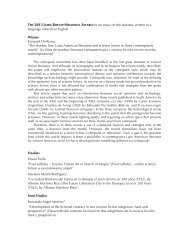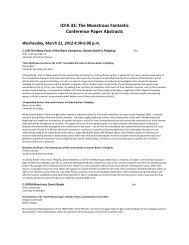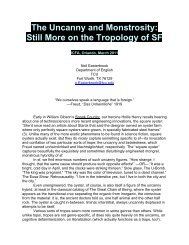however, it has the ability to observe its higher processes occurring, due to the mechanical nature of its body. <strong>The</strong> digient is unique in that ithas the potential to inwardly adjust its mental representation of what it perceives, as its consciousness is not contained in a fragile, physicalconstruct.<strong>The</strong> Philosophy of Mind of Vernor Vinge’s Tine AliensMark BiswasUC RiversideThis paper explores the minds of Vernor Vinge’s tine aliens from his novels, A Fire Upon the Deep and <strong>The</strong> Children of the Sky. How wouldbeings, composed of separate organisms yet united by telepathy, form a philosophy of mind? Would they gravitate to a materialistic or dualisticphilosophy? <strong>The</strong> tines are an interesting species to pose this question because they have extreme aspects of each. For example,“broodkenners” are tasked with creating individuals of four or five compatible members united by telepathy, as well as choosing pups to joinindividuals who have lost members. <strong>The</strong>y are, in essence, in the business of building souls, and this “constructing” lends itself to a materialisticphilosophy. However, in an opposing sense, the material body is less important for the tines––over the course of their lifetimes, they losemembers and add replacements, but despite this, the “essence” of their individuality remains. I will argue that it is the varying philosophies ofmind in the texts, which are preexisting beliefs held––sometimes irrationally and despite evidence to the contrary––which sparks conflict.Beliefs aren’t only held by the tines, of course. Humans place value on their single bodies that tines do not; as such, they find the tines’treatment of discarded members––not much different from the way humans treat cut hair––appalling. In all cases--tines, tropicals, andhumans––characters exhibit cultural blinders, derived from their own philosophy of mind, which prohibit them to comprehend the other’spoint of view.*******Saturday March 24, 2012 10:30-12:00 p.m.114. (SF) Evolution, Rhetoric, and Revision in H.G. Wells’ <strong>The</strong> Time Machine PineChair: John RiederUniversity of Hawai’i-Mānoa<strong>Monstrous</strong> Morlocks and Angelic Eloi: Reading the Evolutionary Signposts in Charles Darwin's Voyage of the Beagle and H. G. Wells’ TimeMachineLisa SwanstromFlorida Atlantic UniversityIn 1839 Charles Darwin publishes the Voyage of Beagle, a narrative account of his five-year journey around the world. Nearly sixty years afterthat, a mysterious stranger known only as the "Time Traveler" steps aboard a strange and motley contraption in order to explore the distantfuture in H.G. Wells' Time Machine. While the two works are not perfect parallels, a careful reading of Wells' book reveals Darwin's influence,especially in the way the Voyage of Beagle evolves from the traditional sea yarn, a hyperbolic adventure medium that Darwin adopts andchallenges. With its departure from England, its encounter with the then-exotic environments of Tierra del Fuego and Tahiti, and with Darwin'striumphant return to England, where he is quickly elected to the Royal Society on the basis of his scientific discoveries at sea (Brown and Nevexi), the Voyage of the Beagle is a quintessential nautical adventure. And the Time Machine, while it does not literally embark upon a body ofwater, uses the metaphor of the sea to express its more speculative voyage through the ages. <strong>The</strong> Time Traveler, for example, at various pointsuses the stars to chart his navigation; he also has encounters in an exotic land (his own, but 800,000 years in the future) and meets strange"races"--the frightful Morlocks and the harmless Eloi. Additionally, he must endure a period of doldrums when the Morlocks hijack his vehiclebefore he can return to his own time.<strong>The</strong> Morlocks’ Raw Deal: De-monstrous Rhetoric in <strong>The</strong> Time MachineLucas HarrimanUniversity of Miami<strong>The</strong> true monster of H.G. Wells’s <strong>The</strong> Time Machine—by which I refer, of course, to the Time Traveller himself—tells a powerful story. <strong>The</strong> talehe relates to his audience of late-Victorian British professionals is, in the words of one Wells scholar, “a story that lies like the truth” (Crossley19). Since the Time Traveller’s subjective interpretations of the far distant future present the only truth of that reality for his hearers and for us,his eventual audience, those impressions prove tenacious in their ability to shape our judgments. One of the most prevalent examples of thisphenomenon involves the question of Weena’s gender or, more accurately, the lack of question in most readings. Although the Time Travellermerely guesses she is a “woman, as I believe it was” (66), his guess becomes reified, both in his own construction of Weena’s role in hisnarrative as the ideal Victorian woman and in the tendency of nearly every subsequent reader to miss the ambiguity of this “queer friendship.”Wells’s text provides a perfect site in which to interrogate the relationship between rhetorical demonstration and monstrosity, its etymologicalcousin. <strong>The</strong> potential power of fiction to “lie like the truth” can have monstrous results, as revealed most clearly in imperial representations ofcolonial spaces. This paper will interrogate the sources of our tendency to view the Morlocks as monsters. When we probe the various thingswe “know” about the Morlocks—they are cannibals, they mean the Time Traveller harm, they are the “inhuman sons of men” to complementthe gentle and angelic Eloi—we realize that all of these traits are as fictitious as Weena’s femininity. Viewed objectively, Morlocks are merelycurious weaklings, ruthlessly massacred by Wells’s blundering intruder. Yet, as film adaptations of the novel reveal in the extreme, readers arelikely to uncritically mimic the Time Traveller’s prejudiced demonstrations
Reading Between the Times: A Critical Analysis of the Revision History of <strong>The</strong> Time MachineAustin SirkinGeorgia State University<strong>The</strong> Time Machine was H.G. Wells’ first major work and, as such, had a much different creation story than his later works, on which Wells spentvery little time revising and editing before publishing, and only continued -- or some would argue began -- the editing process after publication.Yet on his first novel, <strong>The</strong> Time Machine, Wells refined and edited his story over the course of seven years, starting from the serializedpublication of <strong>The</strong> Chronic Argonauts in 1888 until the 1895 publication in the New Review, from which point on it remained largelyunchanged. Since this first novel went through an uncharacteristic number of published revisions (seven, to be precise, two of which have beenlost) it is important to discern what those changes are, and to use those changes as a lens to examine not just existing scholarship of <strong>The</strong> TimeMachine, but of Wells as a writer. What changed in the revisions, why Wells changed his editing habits and which changes are truly importantwill all be discussed in this paper.115. (FTV/SF) <strong>The</strong> Monster in Men: Memory, Culture, and Identity in Doctor Who OakChair: Mike MarraIndependent ScholarA Good Man in a Questionable Empire: Doctor Who and the Anglo-American ExperienceJulian ChamblissRollins College<strong>The</strong> resurrection of Doctor Who in 2005 returned the longest running science fiction program in history to international television audience. Alegacy program revamped in form, but not substance, the modern Doctor Who continues a tradition of cultural education that promotes apositive postcolonial standing for the United Kingdom. Critics and fans alike recognize Doctor Who’s essentially British perspective and perhapsmore than any other program created in the last fifty years, Doctor Who provides the framework for audiences outside the country tounderstand British socio-political agency. Airing in the United States since the 1970s, Doctor Who acts as a signifier of British identity to a U.S.audience that challenges assumption about power, identity, and agency. By examining the recent revival of Doctor Who within the context ofthe show’s long history, a socio-historical contextualisation demonstrates how Doctor Who negotiates shifting global realities for domestic andforeign audiences.Are Monsters Real? Men from the Military and Men in Rubber SuitsNicolas PillaiUniversity of Warwick<strong>The</strong> Barry Letts-produced era of Doctor Who (1970-74) is commonly regarded as the most politically committed of the show’s history, using theDoctor’s exile on Earth to address contemporary social and environmental concerns. James Chapman has suggested that, in this period, ‘DoctorWho was at its most critical of British society’. In this paper I ask how the series articulated political thought through an archetypal figure of thesci-fi genre: the monster. By looking at moments from <strong>The</strong> Silurians and <strong>The</strong> Green Death, I argue that, in this period of the show’s history,monsters invoke the programme’s new commitment to the problems of Earth. In each story, monsters emerge from the soil, warning againsthuman exploitation of the planet’s resources. I suggest three categories to explore: (1) the articulate monster [the Silurians], (2) the mutemenace [giant maggots], and (3) the technological threat [deranged computer B.O.S.S.]. In contrast, I posit the representatives of government –men from the Ministry who evince the programme’s deep suspicion of bureaucracy and militarism. Such figures reveal the monstrous qualitiesin human behaviour and I conclude by reflecting on the traits and representational meanings of monsters in this era of Doctor Who. How doesone spot a monster, and what does it mean when we see one?Time Monsters and Space Museums: Teaching History and Science through the <strong>Fantastic</strong> in Doctor WhoTom StewardBournemouth UniversityDoctor Who (BBC, 1963- ) was originally conceived in part as a television programme that would teach young people about history and science.It was developed in the context of a broadcasting institution that included education in its remit. <strong>The</strong> series is regarded to have largely failed inits pedagogic purpose, said to have been identifiable only in exceptional sub-sections of its 58-year run such as the period-set historical storiesmade between 1963 and 1967 or the ‘hard’ mathematics serials made in 1981-82. In these cases, the assumption is that a movement awayfrom fantasy and monsters towards facts and information made the programme educational. Furthermore, the BBC’s educational emphasis hasbeen questioned, with historians noting a decline in the formal teaching aspects of its television output after the 1960s and arguing that earlyBBC television was more popular culture-oriented than previously thought. This paper argues that Doctor Who became more educational andbetter at teaching when delivered through fantasy and science-fiction, and that the figure of the ‘monster’ was a pivotal learning resource. Itlooks across a range of fantasy and genre-based historical serials thought to be corruptions of the historical story, examining how theyincreased the pedagogical content of the series by adding science-fiction tropes and popular cultural references. It surveys several space-setand time-travel narratives, suggesting how the impact of scientific theory increases power when couched in the language of scientificimpossibility rather than a lecture but also how the series kept its exploration of science within an academic context. It draws attention to theuses of monsters as devices for discussing historical and/or scientific issues such as war, totalitarianism, disease and mutation. Doctor Who’scommitment to education through fantasy storytelling and monstrous imagery will be used to further argue for teaching impacts in popularcultural genres.
- Page 4 and 5:
5. (F) Wondrous Bodies of the Gende
- Page 6 and 7:
Fantastic Suicide: Reading the Unca
- Page 8:
Viral Posthumanism: Boundaries and
- Page 11 and 12:
The Concept of Soul Divisibility in
- Page 13 and 14:
Thursday, March 22, 2012 10:30 a.m.
- Page 15 and 16:
21. (CYA) Terrifying Futures: Post-
- Page 17 and 18: 23. (FTV/H) Now I’m Feelin’ Zom
- Page 19 and 20: Fight Club: Amalgam of the Horrific
- Page 21 and 22: Taking the Monsters out of the Clos
- Page 23 and 24: Kaspar J. SaxenaIndependent Scholar
- Page 25 and 26: 44. (CYA) The Monstrosity of Teenag
- Page 27 and 28: 46. (FTV/SF) Monstrous Spin-offs: T
- Page 29 and 30: 49. (F) Aspects of Miéville Captiv
- Page 31 and 32: 53. (SF) War and Crisis in 1940s an
- Page 33 and 34: Abuse of Power: An Evolutionary Res
- Page 35 and 36: Disappearing Natives: The Colonized
- Page 37 and 38: 60. (H/IF) Ancient and Medieval Mon
- Page 39 and 40: 62. (F) The Works of Tolkien Captiv
- Page 41 and 42: 67. (SF) Imperial and Postcolonial
- Page 43 and 44: Beheading the Gorgon: Beautifying C
- Page 45 and 46: 71. (VPA) Monstrous Music MagnoliaC
- Page 47 and 48: 73. (F/IF) Portraying New Worlds Ca
- Page 49 and 50: Friday, March 23, 2012 2:45-3:45 pm
- Page 51 and 52: 81. (FTV) Those Damn Dirty Apes! Cy
- Page 53 and 54: Friday, March 23, 2012 4:00-5:30 pm
- Page 55 and 56: 92. (F) Leaving the Demonized Other
- Page 57 and 58: 94. (FTV/CYA) Monstrosity and Devia
- Page 59 and 60: of cannibalism, ghostly seduction i
- Page 61 and 62: Saturday March 24, 2012 8:30-10:00
- Page 63 and 64: 104. (CYA) Classic Monsters, Reinte
- Page 65 and 66: 107. (VPA) Monstrous Gaming Bodies
- Page 67: who challenge the order that the Br
- Page 71 and 72: 117. (FTV) Monsters and Superheroes
- Page 73 and 74: 119. (IF/H/PCS) International Mash-
- Page 75 and 76: Focusing on Stoker's Dracula as one
- Page 77 and 78: Florida Atlantic UniversitySheri S.
- Page 79 and 80: Simmons CollegeIn the spate of rece
- Page 81 and 82: Independent ScholarKing’s story
- Page 83 and 84: modernity opens up for every indivi
- Page 85 and 86: Saturday March 24, 2012 4:00-5:30 p
- Page 87 and 88: 141. (FTV) Monstrous Masculinity Cy
- Page 89 and 90: ultimately make peace with her mons
- Page 91 and 92: where the almost-human sentient zom





